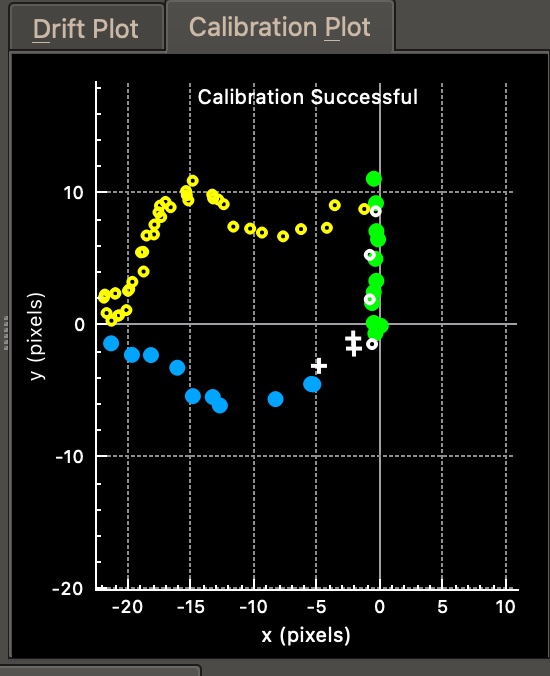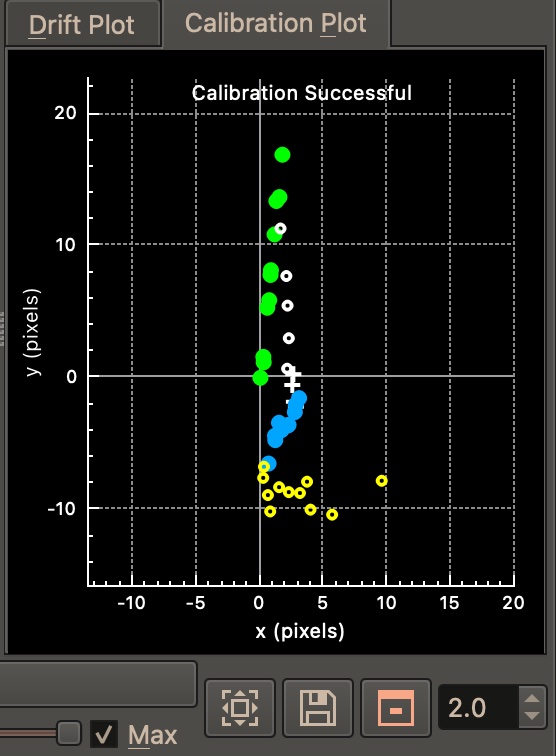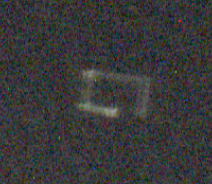INDI Library v2.0.7 is Released (01 Apr 2024)
Bi-monthly release with minor bug fixes and improvements
Poor guiding results with Losmandy mount
- Bill Tschumy
-
 Topic Author
Topic Author
- Offline
- Premium Member
-

- Posts: 102
- Thank you received: 11
Poor guiding results with Losmandy mount was created by Bill Tschumy
Both mounts seem to perform poorly with guiding. I have tried a wide variety of calibration and guiding settings but nothing seems to help.
I am using an ASI220MM guide camera with an off axis guider. The scope is 740 mm in FL.
Here is what the calibration looks like when pointed midway up in the eastern sky. It is generally even worse when pointed to the meridian and celestial equator as recommended.
Here is an example of the guiding I get after that calibration:
Here are my settings (but I've tried lots of variations)
Any thought on what I can try? On the Losmandy forums people talk of concisely getting 0.6" RMS. I'm nowhere near close to that.
Attachments:
Please Log in or Create an account to join the conversation.
- Hy Murveit
-
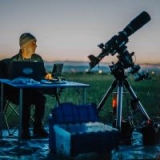
- Away
- Administrator
-

- Posts: 1224
- Thank you received: 566
Replied by Hy Murveit on topic Poor guiding results with Losmandy mount
Guiding is a tricky thing as there can be many reasons why things aren't working well (sky, hardware, configuration).
In another thread I recently posted my usual settings:
indilib.org/forum/general/13595-guiding-setup.html#94250
You should probably start by copying me.
Looking at what you posted, there are a few things that call out to me.
1- Calibration: When you calibrate, allow up to 10 sample points--10 are better than 3.
1b- Similarly your pulse 1500ms is probably way too large--you're going like 10 pixels per pulse. Lower it until you go 2 or 3 pixels per pulse.
1c- I'm suspicious of your calibrated values--you're showing like 4X the arcsec/ms for DEC as RA. Perhaps you have a lot of backlash? Does your mount feel loose?
1d- Definitely just checkout your hardware and make sure things seem secure, not shakey--see 1c.
1e-Calibrate at 10 degrees west of the meridian at the equator. If you can't then something's wrong with your mount or parameters. See 1a, 1b, 1c, 1d.
2- Guide Settings: Don't use integral gain, set those to 0.0.
2b- I'd backoff to about 0.6 or so on the aggressiveness for RA and DEC
3- I'd go with a longer exposure to start, e.g. 3s, and perhaps bin 2x2.
4- If conditions aren't good, then don't try to improve. Optimize your settings on a "good night".
Best of luck and keep posting,
Hy
Please Log in or Create an account to join the conversation.
Replied by Alfred on topic Poor guiding results with Losmandy mount
What strikes me about the settings is integral. As Hy said, I'd set this to 0.
Don't give up, the internal guider definitely can achieve much better results than what you have seen so far.
Please Log in or Create an account to join the conversation.
Replied by Alfred on topic Poor guiding results with Losmandy mount
Please Log in or Create an account to join the conversation.
- Bill Tschumy
-
 Topic Author
Topic Author
- Offline
- Premium Member
-

- Posts: 102
- Thank you received: 11
Replied by Bill Tschumy on topic Poor guiding results with Losmandy mount
Thanks for chiming in. I will try your suggested settings although I think I've tried things close to that previously. The current ones were suggested by another Losmandy/Ekos user as they worked well for him.
Some specific comments:
1c- I'm suspicious of your calibrated values--you're showing like 4X the arcsec/ms for DEC as RA. Perhaps you have a lot of backlash? Does your mount feel loose?
No, I don't think I have a lot of backlash. I've adjusted that ad nauseam and I think I have it close to optimal. Any tighter and I can get motor stalls. I use an ammeter on the power supply to ensure I don't have it too tight or too loose.
1e-Calibrate at 10 degrees west of the meridian at the equator. If you can't then something's wrong with your mount or parameters. See 1a, 1b, 1c, 1d.
I have tried that although I generally do it a few degrees east of the meridian (does that matter?). For whatever reason, my calibrations at that location look even stranger than the ones I showed. Next time I try I can post examples from there.
Guide Settings: Don't use integral gain, set those to 0.0.
2b-I'd backoff to about 0.6 or so on the aggressiveness for RA and DEC
I've tried all permutations of the integral gain and aggressiveness. 1.0 works the best for me but I will experiment again using your new settings.
3- I'd go with a longer exposure to start, e.g. 3s, and perhaps bin 2x2.
I've tried this as well with no improvement. As far as binning, the ASI220MM camera seems to hang if I try 2x2. No idea why.
I do live in the Rocky Mountain Front Range (just was to the Rockies in Colorado). The seeing is generally somewhat poor due to turbulence for the prevailing winds coming over the Rockies. However other people in my area are able to get much better results than I can.
I'll let you know after I try your suggestions on the next clear night. I'm also going to try calibrating/guiding using my main camera just in case there is something strange going on with my OAG setup.
Please Log in or Create an account to join the conversation.
- Bill Tschumy
-
 Topic Author
Topic Author
- Offline
- Premium Member
-

- Posts: 102
- Thank you received: 11
Replied by Bill Tschumy on topic Poor guiding results with Losmandy mount
Balance is good. I've verified that many times.
Thanks for the suggestions.
Bill
Please Log in or Create an account to join the conversation.
- Frederick Ruegsegger
-
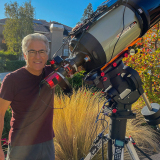
- Offline
- Elite Member
-

- Posts: 211
- Thank you received: 30
Replied by Frederick Ruegsegger on topic Poor guiding results with Losmandy mount
Perhaps this is too obvious but I'll jump in anyway since I recently had this happen. I was getting calibration plots like yours (and worse) and the subsequent guiding was awful. After two hours of playing with settings and recalibrating I decided to double check my polar alignment (I had polar aligned earlier in the evening). It was off by about half a degree. After adjusting the PA, my calibration plot improved considerably and my guiding improved to acceptable levels.
I'm now in the habit of running PA twice each time I set up (I don't have a permanent installation). I often get different answers on the second run and refining PA has made my guiding consistently better.
Please Log in or Create an account to join the conversation.
- Bill Tschumy
-
 Topic Author
Topic Author
- Offline
- Premium Member
-

- Posts: 102
- Thank you received: 11
Replied by Bill Tschumy on topic Poor guiding results with Losmandy mount
Thanks for the suggestion. I did run the PA routine twice the other night, in part because my initial starting point was a couple of degrees off (I had used the mount somewhere else recently). I think the PA was pretty good at the end.
It may or may not be true but I've read Guiding can actually be better if you are slightly off polar alignment. Not sure what they meant by "slightly".
Bil
Please Log in or Create an account to join the conversation.
- Bill Tschumy
-
 Topic Author
Topic Author
- Offline
- Premium Member
-

- Posts: 102
- Thank you received: 11
Replied by Bill Tschumy on topic Poor guiding results with Losmandy mount
So I'm still getting really weird calibration plots. I used the calibration settings Hy recommended. This is one done at the optimal RA/Dec, near the celestial equator and close to the meridian
As usual, the RA forward/backward drift seems reasonable. However the Dec is strange. The blue dots wandered over to the left, not in a straight line, but it got there. Then on the backward Dec drift it took an even stronger route. The calibration did complete and I was able to get around 1.3" RMS guiding with this. However, I did find that turning the Integral Gain up to 1.0 on both axes results in better guiding than using 0.0.
Here are the resulting calibrated values from the above calibration:
Earlier I got even screwier results during calibration.
In this case the Dec drift didn't go to the left as expected but rather went down. The Dec backwards drift did go to the right.
What could be causing these strange calibrations? My mount seemed to be performing well. I could GoTo a star and then Plate Solve and Center it with no issues.
I just have the feeling there is some crucial setting I have wrong, but I have no idea what it could be.
Bill
Attachments:
Please Log in or Create an account to join the conversation.
Replied by Alfred on topic Poor guiding results with Losmandy mount
DEC calibration looks weird, indeed. Two things you could try:
1. Dismount the DEC motor, keep it in your hand close to your ear, with ony finger slightly touching the pinion. Now press the North button (very slow speed) on your hand controller. Feel and listen whether the motor moves smoothly. After that, repeat with the South button. Once I've seen a broken motor that would make a funny noise (although quietly) and move irregularly.
2. Swap RA and DEC motors and cables to find out whether the funny calibration paths move over to RA then.
Another check would be this: Under the night sky, with tracking activated, go to the CCD tab and start a 60s (or whatever it takes) frame. While the frame is being taken, go to Indi settings -> CCD cam -> Guider Control. Enter something like 600 in the 2nd "North (ms)" field and press "Set" 5 times (wait a second in between). The guider should move the mount 5x for 600ms to the north. Depending on the focal length of your scope, it could take longer pulses to get a reasonable result.
Then delete the 600 by setting the field back to 0 and enter 600 in the 2nd "West (ms)" field and press Set 5 times.
Then repeat with South and East. What you should get is an image that shows all stars moving 5 pulse steps a 600ms to the north, west, south and east. Their trails should form small "boxes". These boxes should be "closed" on all sides.
What I got with my mount using pulse guiding is this:
(My G-11 has a rare issue that causes calibration to move in RA like 5 pixels per pulse in one direction but 3 pixels per pulse in the opposite direction. This happens with "pulse guiding" only. When I connect Ekos to the mount via ST-4 cable, the issue does not occur. The "box test" is how I found out about it.)
Attachments:
Please Log in or Create an account to join the conversation.
- Bill Tschumy
-
 Topic Author
Topic Author
- Offline
- Premium Member
-

- Posts: 102
- Thank you received: 11
Replied by Bill Tschumy on topic Poor guiding results with Losmandy mount
Thanks for the suggestions. I have swapped motors and checked them. I don't think that is the issue.
I will try the box test. That's a good idea.
Can someone explain want is actually happening during calibration? It is called a 'drift plot" but is sounds like thing are not really drifting. I assume it is similar to what Alfred described with the box test. It pulses some number of times in one direction and then pulses in the opposite direction to get back, both RA and Dec. I just don't see how it can be watering around in Dec so much.
I have tried this on my G8/11 mount as well as the GM8 mount. My recollection is that tree Dec did strange things there as well. That is why I'm wondering if it is some setting of something about my guide camera. I was going to try calibrating using my main camera to see if that made any difference. I guess I could also try ST4 guiding but that may be another whole can of worms.
Please Log in or Create an account to join the conversation.
- Hy Murveit
-

- Away
- Administrator
-

- Posts: 1224
- Thank you received: 566
Replied by Hy Murveit on topic Poor guiding results with Losmandy mount
The goal of calibration is to find 2 numbers for each axis. The direction in camera-pixel space that the RA (and DEC) motors drive a given position on the image, and how far that point gets driven: how many millisecond-of-pulse needed to drive how many arc-seconds. Note arc-seconds travelled and pixel distance travelled are easily converted. After a successful calibration you can find the values in the guider's options menu in the calibration section.
You can imagine that once these values are known, then when the guider detects that the camera position has drifted from a desired position by a certain amount, it can attempt to correct this undesired movement by sending the appropriate compensating RA and DEC pulses.
To find these values, the system does a very simple "dance". It starts by taking a picture and "defining" the current position (e.g. the pixel position of a guide star, or a group of stars). It then drives the RA motor a number of pulses (e.g. 10 iterations of "pulsing for 500ms, taking a picture, solving for position") and sees where it wound up. From this it solves for the RA direction and its ms/arc-second. E.g. if it pulsed a total of 5000ms and moved 10 arc-seconds it would be 500ms-per-arc-second. It then returns to its start position without and further measurement. That is, the return flight is not used. It then does the same for DEC, except that it initially pulses until it detects movement, to remove any backlash from the measurement, and it defines its start position once it has cleared the backlash.
There are a couple of complications. (1) Assuming you want to calibrate once and use it over and over (which is recommended), the image will invert when taken on the other side of the pier, so this has to be accounted for in the direction vector. (2) The distance traveled in pixels for a given angular change in RA depends on the declination. E.g. very very close to the pole, you can travel 360º in RA and only traverse a few pixels. There is a declination compensation used for the RA ms-per-arc-second values. (3) There is curvature close to the poles, so these calibration "approximations" don't work very close to the poles.
Of course, there are many things that can make these calibrations inaccurate. Among those are backlash, flexure, balance, measurement error, ...
Hy
Please Log in or Create an account to join the conversation.






